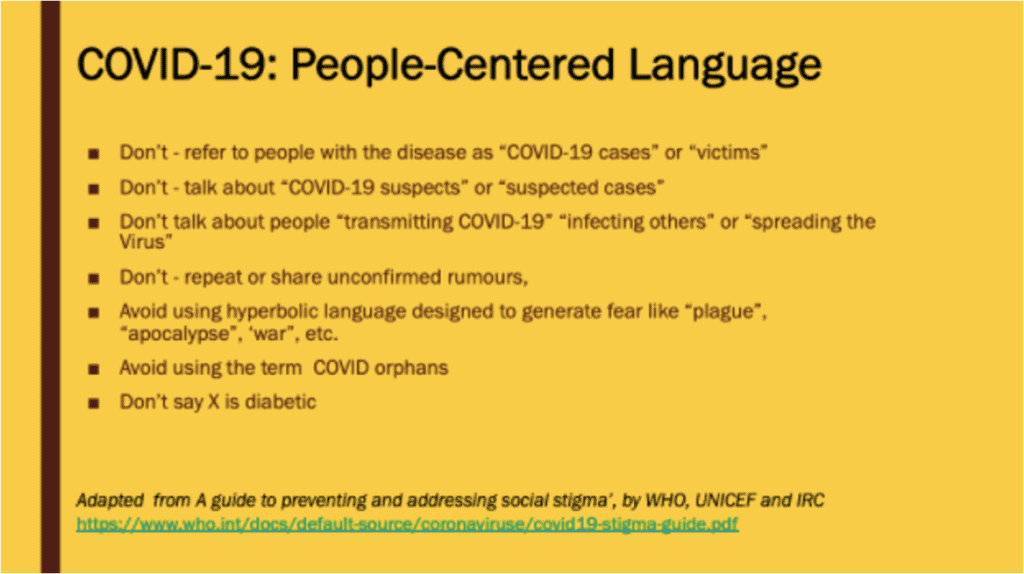“But if thought corrupts language, language can also corrupt thought.”
― George Orwell, 1984
How do we use language to shape and control thoughts? How do we use language for behaviour change? How do we use language for affirmative action? How do we use language to respect the person as a whole rather than as a trait, a diagnosis or a condition?
In the early days, before the World Health Organisation (WHO) declared COVID-19 as a pandemic, one term that repeatedly made the rounds was ‘social distancing’. Benign as it sounds, to behave responsibly by maintaining a certain physical distance from the next person, the phrase, however, only exacerbated the age-old bias of what, and who, is clean. The term was stigmatising and many felt it would lead to more discrimination.
The WHO later clarified that what was meant was ‘Physical not Social Distancing’. A UNICEF website stated: “The term social distancing is misleading, because in times like these we need to stay emotionally and socially connected”.
Interestingly, early this year, I came across a paper titled “Rebranding social distancing to physical distancing: calling for a change in the health promotion vocabulary to enhance clear communication during a pandemic” by Kristine Sørensen, Orkan Okan, Barbara Kondlilis and Diane Levin- Zamir. The authors made the case for using proper terminology when communicating life-saving public health messages.
Read more: What’s the toll COVID is taking on mental health?
Lessons in Language
“A different language is a different vision of life.”
—-Federico Fellini
A throwback to August 2020, when I was applying for a grant for community radio. One question the funders posed was on the need to address stigma and discrimination. How should communication be centered, given that people were afraid to get tested as it might expose them to our collective prejudices and internalised biases of racism, casteism, misinformation and shame? How does one then change from using the language of fear of the unknown to that of empathy?
While we did not get the funding, I started scanning media reports more attentively. Terms like infected, suspect, suffering from, victim and carrier don’t just objectify, criminalise or blame the individual but also dehumanise and separate people when the need of the hour is solidarity.
In my own experience, working with different communities, the emphasis should be on people-centered language rather than the use of identity first, unless the person so desires. Person/People-centered language emphasizes the person first, for positive relationships, and is more respectful. More so in the case of COVID and its diagnosis.
The experience also taught me that there’s more to people than labelling and it is equally important to not overshare information when talking about a person.
A quick ready reckoner for a people-centered language is a document titled ‘A guide to preventing and addressing social stigma’ by WHO, UNICEF and IRC and has some handy recommendations on the kind of language to be used:
Don’ts

Read more: How to cope with mental health fallout from COVID
Do’s
- Say, people who have COVID-19
- Say, people who are being treated for COVID-19
- Say, people who are recovering from COVID-19
- Say, people who died after contracting COVID-19
- Say, people who may have COVID-19
- Say, people who are presumptive for COVID-19
- Say, people who have acquired or contracted COVID-19
- Say, children orphaned by COVID
- Say, X has Type 2 diabetes
Just as I was concluding this article, I saw the the word ‘COVID Widow’. Why do we define women by marital status to convey helplessness or incompleteness or as dependent in relation to men? Can linguistic disparities correct social inequity? Why does family-centered language exclude women and treat her as an object devoid of her individuality?
I end with a quote from T.S. Eliot’s Four Quartets:
“For last year’s words belong to last year’s language
And next year’s words await another voice
And to make an end is to make a beginning.”
With inputs from Rohini Malur
References
Rebranding social distancing to physical distancing: calling for a change in the health promotion vocabulary to enhance clear communication during a pandemic”, by Kristine Sørensen, Orkan Okan, Barbara Kondlilis and Diane Levin- Zamir
Using Person Centered Language – Resources for Integrated Care
‘A guide to preventing and addressing social stigma’, by WHO, UNICEF and IRC